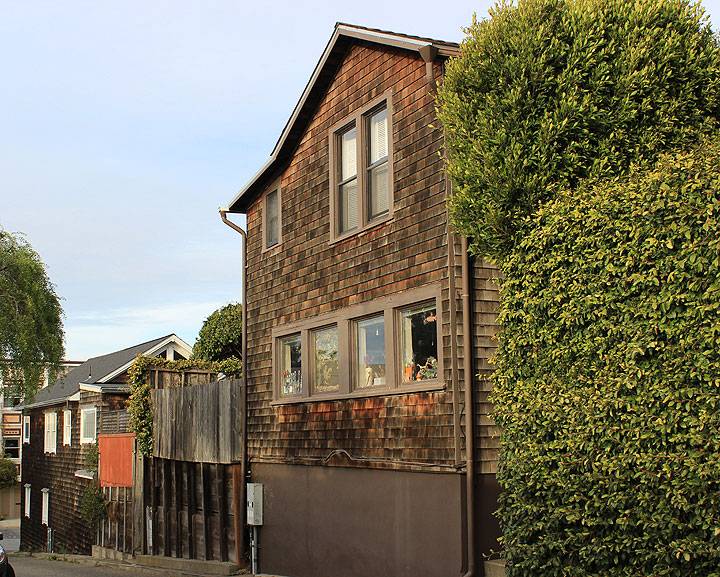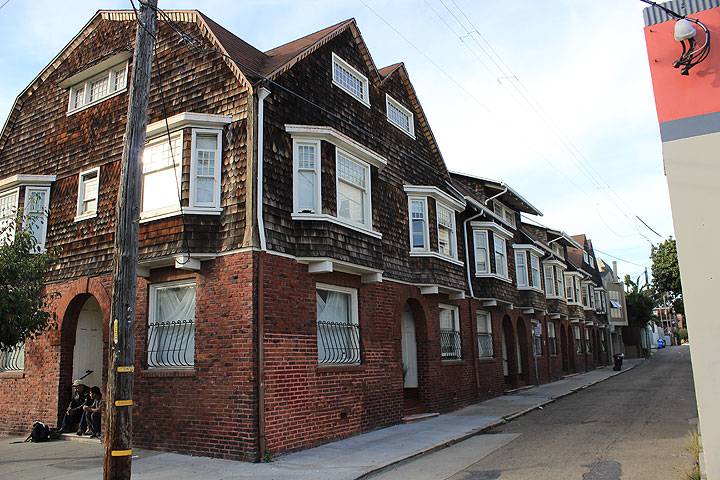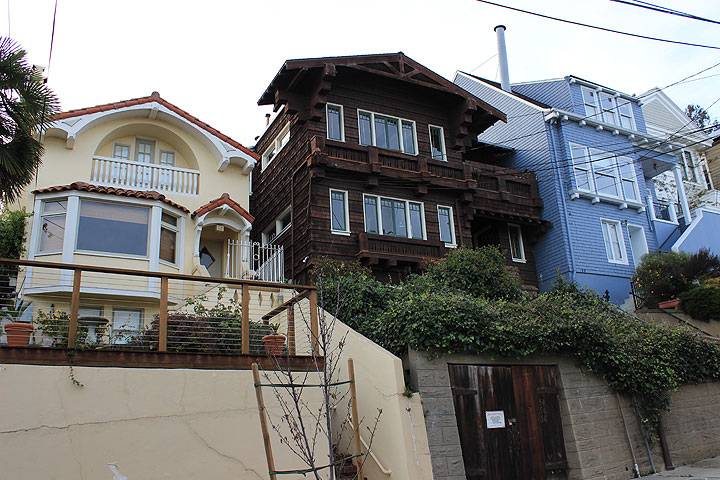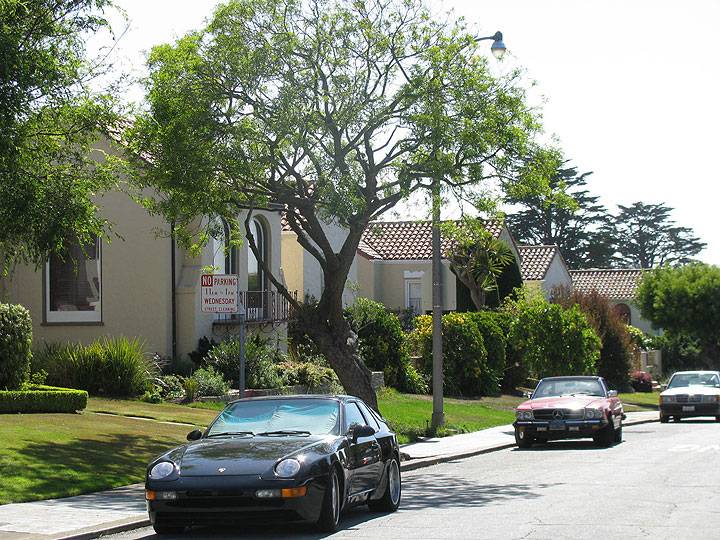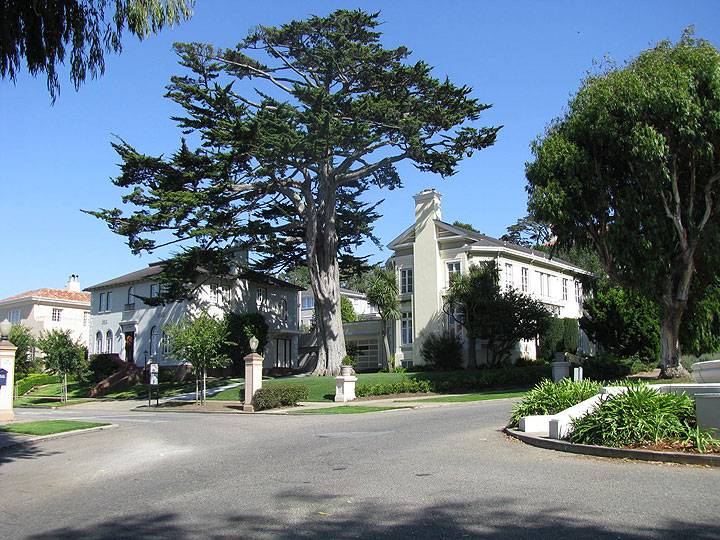The Ecotopian Middle Landscape
Historical Essay
by Richard Walker
Originally published in Ecumene, 1995, Volume 2 Number 1
Craftsman style homes on Liberty Hill between 20th and 21st Streets in San Francisco, 2014.
Photo: Chris Carlsson
By the turn of the century, Bay Area architecture and suburban design broke with the consciously urbane style of San Francisco. As a result, the region is blessed with a distinctive type of residential ecology, the ecotopian middle landscape. The mock cabin, craftsman styling and the brown shingle are this landscape's characteristic way of building; its homes are tucked into hillsides along narrow, winding streets that echo the terrain; and the interstices are heavily wooded with native oak, redwood and chaparral, as well as eucalyptus, plum, deodar and a profusion of imports. Romantic and naturalist in inspiration, the look of these bohemian groves is artfully unkempt: a semi-wild vision of a city in the woodlands and woodlands in the city. The ecotopian suburbs are where large numbers of the Bay Area's abundant stock of professionals, technicians and managers, as well as many of the owning class, make their abode. It is the arch typal landscape of a libertarian, bohemian middle class who lend a special social flavor to local society, and has sequestered many an arcane social practice and political thought over the years- from Isadora Duncan's modern dance to Gary Snyder's Zen environmentalism. It has been projected onto the whole of the Pacific Northwest as Ecotopia by Berkeley's Ernest Callenbach, and by Joel Garreau in his Nine Nations of North America held up as the last redoubt of a populist vision of the American middle class as the bearers of a moral order equally opposed to capitalist and comrnunist savagery. (15) The ecotopian middle landscape is thus a curious variant of the bourgeois Utopias that dominate suburban form across the United States. The look is neither English garden nor crabgrass frontier, having been modified by California's climate, physiography and materials, as well as by conscious design. Nor is the Utopian vision that of the upright bourgeois conservative; in its fierce environmentalism and quasi-religious idealism it is more akin to Wilberforce's London Evangelicals than to Reagan’s New Republican Majority. (16) All the same, the Bay Area’s bohemian enclaves partake of many of the same illusions as all suburban hideaways.
Craftsman and brick cottage apartments at 26th and South Van Ness in San Francisco's Mission District.
Photo: Chris Carlsson
The leading example of the bohemian forest suburb is north Berkeley, but the same social ecotone stretches for miles along the East Bay hills. It even makes unexpected appearances in San Francisco (at Russian Hill and on the flank of Twin Peaks). These are all thought of as ‘central city’ areas in the metropolitan scheme of things today, yet they were once on the suburban fringe. Ecotopian suburbs are abundant north of the Golden Gate in Marin County and run down the hilly spine of the San Francisco Peninsula all the way to Silicon Valley. And they are presently advancing along a broad front in the arcadian North Bay of Napa, Sonoma and Mendocino counties. While some of the wealthier areas in this zone are the territory of big estates of the haute bourgeoisie (Hillsborough, Ross, Saratoga), grand mansions are not the central element of ecotopia.
The Bay Area's bohemian suburbs were born in the heady days around the turn of the century, when a fever of civic rebirth overtook the region. As the mining era wound down, the city was due for a transformation in every domain, including urban form. A wave of growth after the depression of the 1890s continued without pause to the First World War: building activity was ferocious, skyscrapers shot up, and the city prospered mightily. Wages rose and grand schemes for urban renewal were concocted for San Francisco, while a vast new push took the city outward. Faster transport by electric trolley, gasoline-driven ferries, and early automobiles helped propel the outward march of residential suburbs, as did the dispersal of industry and commerce into the East Bay. The earthquake and fire of 1906 accelerated a diaspora already underway.
The suburban revolution was as much a class project as the Victorian landscape had been, led this time by a prosperous new generation of businessmen and their families, joined by an expanding middle class of doctors, professors and insurance executives—most of whom were fresh out of the new universities at Berkeley and Stanford. The design problem facing developers, architects and engineers was to carve out spaces appropriate to the sensibilities of a more sophisticated elite of capitalists, high-paid staff and credentialed intellectuals. This class project cut right across the United States at the time, but took a special twist in the Bay Area with its peculiar landscape architectural innovations and community politics. Three conditions had to be satisfied in this ecotopian quest: a sylvan artful and thoughtful community planning.
<iframe width="560" height="315" src="https://www.youtube.com/embed/ndurywX8vgo" frameborder="0" allowfullscreen></iframe>
The San Francisco Houses of Architect Bernard Maybeck
Video: Glenn Lym
The first element of the new suburban form was the treatment of natural landscape. In California, the English garden ideal gave way to the romance of the wilds and a love affair with the aesthetics of a Mediterranean land. The conservationist urge was at a high pitch due to general repugnance at the untrammelled brutality visited on the state by mining, lumbering and environmental plunder over the previous half-century. To this was joined a more genteel goal of bringing Nature under the wing of civilized pursuits, such as hiking, outdoorsmanship, and taking the waters at hot springs. Naturalism was a coat of many colors made up of both the dissipated revels of the Bohemian Club and the ascetic creed of John Muir. But its participants shared a certain mystical religiosity—part transcendental, part Masonic, part romantic—about Nature and art, with the Big Trees and Yosemite Valley as universal icons. Their goal was to marry the resort to city life, and to enjoy a cultivated rusticity in both the land and themselves. (17)
Unlike the English or Philadelphia mainliners, the California burghers could not call upon a settled countryside of well-peopled farms to inspire their Arcadia; they had to go straight to the woods—all the more so because San Francisco was so barren. (18) The best places were tiny pockets of second-growth redwoods; lacking this, bay laurel and oak woodlands would do. But since most of the hills were grasslands, the new suburbanites started planting trees and shrubs with a vengeance, transforming open vistas into the thicket of greenery which today strikes the eye (large developers also planted thousands of pine and eucalyptus). Today's residents are surprised by old photographs showing barren hills behind Berkeley and other bohemian retreats, disbelieving that theirs is a cultivated rusticity in such a literal sense.
The second element of the rustic suburbs was house style, and so into the urban woodlands came the architects to build homes for well-to-do patrons. A burst of professional creativity took place in the Bay Area with the arrival of a handful of exceptional talents in the 1890s: Willis Polk, A. C. Schweinfurth, A. Page Brown, Ernest Coxhead and Bernard Maybeck (joined after 1900 by Julia Morgan and John Galen Howard). This brilliant circle was a part of the new wave of architecture coming out of Paris, the new schools of professional design in the US, and the New York firm of McKim, Mead and White. The new wave rejected the falsity and incoherence of Victorian architecture in favor of a studied simplicity and integrity of design, harkening back to classical forms of Rome and Italy and vernacular styles from England, France and Colonial America, and they were fascinated by the possibilities of the local terrain. (19)
The new architecture was eclectic here, as elsewhere: Polk could design everything from Renaissance office buildings to Appalachian hunting lodges; Maybeck could produce a Beaux Arts Palace of Fine Arts as easily as Swiss chalets; Julia Morgan would do any style—in the case of William Randolph Hearst's egomaniacal San Simeon, all of them at once. This jumble became characteristic of twentieth-century American suburbia, embracing half-timber, turrets and Moorish arches alike in a magical mystery tour of half-baked world history domesticated for middle-class consumption. The haute version of this is to be found in Pacific Heights and country manor but the bohemian woodlands, too, absorbed all styles and shapes. While it is moot whether the Bay Area group can lay claim to any unique style, they came up with two distinctive contributions: the rustic cottage and Mission revival. (20)
Craftsman duplex on Vicksburg in San Francisco's Noe Valley.
Photo: Chris Carlsson
The rustic cottage took its studied simplicity from the English cottage movement, its shingled walls and plain interiors from New England, and married both to the mountain cabin and the Italian village. (21) Clinging to the region's hillsides, the rustic house could be unassuming and still offer the occupant the grandeur of the view over the bay. (The split-level house evolved easily here, as did the picture window and the open-air deck.) Wood construction allowed a ‘freer arrangement of space and mass on a low budget than was possible with masonry.’ (22) Unvarnished redwood came back into fashion, along with the Arts and Crafts aesthetics of Ruskin and Morris, and the influences of Japanese craftwork. Berkeley’s intellectuals occupied hundreds of brown-shingle homes designed by Maybeck and his followers, and Maybeck became the sage and inspiration to the bohemian community living on what local businessmen called ‘Nut Hill’ north of the University campus. (23)
Mission style bungalows in western San Francisco.
Photo: Chris Carlsson
The Mission style grew out of the 1880s rediscovery of Old California, a world so fully obliterated by the 49ers that it could be safely romanticized by the Daughters of the Pioneers. It originated in the Bay Area, particularly the stunning quadrangle complex of Stanford University and Brown and Schweinfurth’s California Hall for the Chicago World’s Fair, but was more appropriate to the sun-bleached climes of southern California where the myth of the Californios had more purchase. In this it was the reverse of the shingle style, where Greene and Greene of Pasadena were the greatest practitioners but which was more widely adopted in northern California. (24) The Mission style was part of a broader borrowing from Mediterranean prototypes to construct a distinctive California landscape and culture, and for all the myth-making involved, this effort left a most agreeable legacy of domestic architecture throughout the state. (25)
Modern architecture, by contrast, had little impact on the Bay Area and its bohemian hideaways, despite such early modernist impulses as simple lines, the use of concrete, exposure of functional structure, and use of industrial windows, especially by Maybeck. Prairie style and international style houses mingle freely with redwood cottages, and are softened, in most cases, by redwood plank siding. In the 1930s, William Wurster and John Cooper Funk married modernism to the Bay Area tradition of wood finish and respect for the landscape. Frank Lloyd Wright, Louis Kahn and LA's R. M. Schindler and Richard Neutra all adapted to the regional predilection for wood and naturalized landscaping in their Bay Area homes. (26)
The third element in the ecotopian constellation has been a strong planning ideal embodied in suburban enclaves of the middle and upper classes. Here, too, originality is not so much at issue as the enthusiasm of key developers and the sustained involvement of the residents in community planning. Early precedents for Romantic suburbs go back to the mid-nineteenth century in the US: Andrew Jackson Downing's sketches, Alexander Jackson Davis' Llewelyn Park (1857), and Frederick Law Olmsted and Calvert Vaux's Riverside (1869) set the precedent for the contoured lines of the unified subdivision, in place of the ubiquitous American grid. Natural topography, creeks and woodlands were all carefully preserved in the naturalistic plans of the Romantic suburb.(27) But the generalization of planned suburban developments only came in the 1890s, led F. L Olmsted Jr's Roland Park (1891).
To be the romantic suburb required a large scale of operations and a separation of residential areas from commercial and industrial land uses. A new breed of developers worked up a parcel of outlying land into a prescribed living environment (a far cry from the indiscriminate selling of individual lots in a plat of the nineteenth century). Control of house and yard standards and exclusion of discordant uses was secured first through deed restrictions, and then through zoning ordinances and subdivision regulations. Utilities such as electricity, telephones and gas became a normal feature of the ‘improved’ subdivision. Houses were constructed in close association with the opening up, section by section, of the planned district, while allied real estate companies promoted the homes and the idyllic way of life. In all this, private initiative usually preceded government planning. (28)
The first such planned enclaves in the Bay Area were laid out from 1889-95 by Michael O’Shaughnessy in Marin County (Mill Valley and Belvedere) and on the Peninsula (Hillsborough). The East Bay’s first such private development did not come until after 1900, in Berkeley (the Claremont, Cragmont and Northbrae districts) by realtor Duncan McDuffie and in Oakland (at Trestle Glen, Park View, and other projects of the giant Realty Syndicate). McDuffie also built idyllic St Francis Wood on the western flank of Twin Peaks in 1912. (29)
St. Francis Wood, 2014.
Photo: Chris Carlsson
Community planning in Berkeley became, characteristically, a social movement, where a group of faculty wives organized the Hillside Club in 1896 in order to force the city to adopt enlightened design principles (after Cedar Street was rammed straight up the hill). They turned north Berkeley into a warren of sinuous, narrow streets joined to the main trolley thoroughfares by steps and paths, as well as leading the effort to create a huge greenbelt park in the Berkeley hills. (30) Cultivated rusticity also triumphed over beaux-arts neo-classicism of the sort embodied in an 1895 plan to make the University campus into a 'City of Learning' and Berkeley into the Athens of the West—an idea dreamed up, ironically enough, by the fertile imagination of the young Maybeck. (31)
Indeed, California led the nation in real estate regulation. The first exclusionary zoning laws in the country were adopted in the 1880s by Modesto and San Francisco to rid Anglo zones of Chinese. Every integrated development came with racial covenants and other deed restrictions from the 1890s onward. Subdivision maps were first required in California in 1893 and the regulations upgraded again in 1907, 1915 and in the 1920s. Los Angeles introduced the first comprehensive zoning act in 1908 (upgraded in 1915). Berkeley's McDuffie came up with the idea of single-use and large-lot to confine commercial activities to designated areas and restrain further subdivision of exclusive domains—which became the norm throughout the United States after 1915. Berkeley also put into effect a sophisticated ordinance to protect factory owners from complaints by working-class neighbors. (32)
Ecotopia got its first rude shock with the north Berkeley fire of 1923. Shingle-style wooden houses lost favor after 600 of them were swept away in a single autumn day. Community power and design with nature suffered another blow when the aesthetics of football triumphed at the University and a huge stadium was jammed into scenic Strawberry Canyon. The brief efflorescence of bohemian experimentation tailed off through the 1920s. Nevertheless, the ambience of cultivated rusticity lives on to charm generations of new arrivals looking for a middle-class sanctuary that is neither too well ordered nor too far from the city streets.
The ecotopian landscape did not die out as a money-making model of suburbanization, however. Rustic, ranch-style homes of the 1940s and 50s continued to be tucked into the hillsides, canyons and oak woodlands as the leading edge of urban expansion moved to the southern Peninsula, up Marin’s central corridor, or beyond the Berkeley Hills. (33) In the 1960s, community activism and design with nature were renewed with a vengeance, and the rustic Bay style made a comeback with the help of Berkeley’s Joe Esherick and LA’s Charles Moore, whose design for the seaside cabins of Sea Ranch up the Mendocino Coast harkened back to the Maybeck and Wurster’s board-and-batten work. When the University of California expanded to Santa Cruz, the motif was a bohemian retreat in the redwoods. Silicon Valley millionaires today buy into cozy ecotopias along the western foothills, from Los Gatos to Woodside, with the same ease as rich stockbrokers rubbed elbows with Maybeck’s minions in Berkeley. Los Angeles, by comparison, left Pasadena’s Arroyo culture behind and went on to become a world center of modernism to which San Francisco was generally unreceptive; LA remained a more laissez-faire city, whose charm of the 1920s and arts and crafts counterculture were all but expunged, while the Bay Area poked along, nursing its delights, holding developers to a higher standard, and cultivating bohemian fantasies. (34)
This idyllic vision was again shattered by the firestorm of October 1991. In a matter of hours, a raging inferno whipped up by desiccating, easterly winds consumed over 3000 homes in Oakland and Berkeley. Losses totaled more than $1.5 billion, making it the costliest urban fire in the United States since 1906. The following day revealed a moonscape of devastation. Chimneys and blackened tree trunks stood in mute testimony to the passing inferno, where oven-like temperatures had melted cars and girders into twisted relief. Most residents lost everything. No one was prepared for such a holocaust, because few recognized the hillsides and canyons for what they were: an urban forest. This was nothing less than a forest fire in the middle of a city, and forest fires burn with an intensity and at a scale unimaginable in urban terms. If San Francisco is 'the city that waits to die', the ecotopian suburbs are no less a death trap when the Diablo winds funnel out of the hot interior, and humidity plummets from coastal to desert conditions in a few hours. Suddenly, a felicitous accommodation between city and country turns out to be a bald affront to natural hazards and good sense. Urbane anti-urbanism proves, in the end, not to be the best of both worlds, city and woodland, but possibly the worst. As in San Francisco in 1906, property owners were adamant about proceeding without restraint. Rebuilding in the fire zone is nearing completion today, with few changes in roads, utilities or building standards. (35)
Rebuilding has revealed another unanticipated threat to the ecotopian way of life: monster houses. Land in the heart of a large and wealthy metropolis has a market value much greater than one would suspect from the small cottages once in vogue. Middle-class incomes have surged, putting $0.5 million houses within range of many. While the first houses rebuilt tended to replicate beloved lost homes, many burghers have thought to expand their enclosed spaces in keeping with the usual American spatial exuberance: average floorspace has jumped up to 2800 square feet, billious houses covering up most of their modest lots. An architectural review team likened the effect to train cars perched on the hillside, and decried clumsy designs and the loss of open terrain and spirit of unity. Styles have also changed with the times, favoring hulking, tasteless and cheap Mission Redux, power plinths of the 1980s coming to taunt bohemia’s declensions. The unchecked market is in revolt against the planning idea and the Reagan generation appears to have little use for the fuzzy virtues of ecotopian romantics.
continue reading --> Multiple-Unit Buildings
previous essay --> Victorian Order
Notes
15. E. Callenbach, Ecotopia (Berkeley, Banyan Tree Books and J. Garreau, The Nine Nations of North America (Boston, Houghton-Mifflin, 1981).
16. Suburban residential spaces for the bourgeoisie go back to the late eighteenth century in Britain and the mid-nineteenth century in the United States, which imported the key elements of these from Britain. The key US of the new domestic and residential order were Catherine Beecher, Andrew Jackson Downing and Calvert Vaux. See R. Fishman, Bourgeois Utopias: The Rise and Fall of Suburbia (New York, Basic Books, 1987); K. Jackson, Crabgrass frontier: the suburbanization of the United States (New York, Oxford University Press, 1985); and R. Walker, 'The transformation of urban structure in the 19th century United States and the beginnings of suburbanization.' in K. Cox, ed., Urbanization and conflict in market societies (Chicago, Maaroufa, 1978), pp. 165-213. But the class project had considerably broadened with the growth of the social division of labor and of cities by the turn of the century. On the rise of the new middle class, see, for example, J. Kocka, White Collar Workers in America, 1890-1940 (Beverly Hills, Sage, 1980); and M. Safatti-Larson, The Rise of Professionalism (Berkeley, University of California Press, 1977).
17. G. Brechin, ‘Living the dream in Berkeley,’ California Monthly (March-April 1984), pp. 24-25. On early tourism, see E. Pomeroy, In Search of the Golden West: The Tourist in Western America (New York, Alfred Knopf, 1957). On Muir, see R. Nash, Wilderness and the American Mind (New Haven, Yale University Press, 1967).
18. Although, as R. Longstreth, On the Edge of the World, Four Architects in San Francisco at the Turn of the Century (Cambridge, MIT Press, 1983) points out, the rustic house was worked out first on Russian Hill, before spreading into the surrounding suburbs.
19. The best account of the Bay Area architecture of this period is by Longstreth, Four Architects. Like most architectural historians, however, he fails to situate the development of architecture in the wider context of professionalization of skilled work and growth of academic study. Other local accounts are T. Anderson, E. Moore and R. Winter, eds., California Design, 1910 (Pasadena, California Design Publications, 1974); and L. Freudenheim and E. Sussman, Building With Nature: Roots of the San Francisco Bay Region Tradition (Santa Barbara, Peregrine Smith, 1974).
20. Typical of the Bay Area arts is less a particular style or styles than a tolerance that lets a hundred flowers bloom and sequesters the odd genius working at cross purposes with New York or Paris. This is abundantly evident in music and the graphic arts; see, for example, T. Albright, Art in the San Francisco Bay Area, 1945-1980: an illustrated history (Berkeley, University of California Press, 1985); and J. Gioia, West Coast Jazz: Modern Jazz in California, 1945-60 (New York, Oxford University Press, 1992).
21. On McKim, Mead and White's shingle style, see V. Scully, The shingle style and the stick style (New Haven, Yale University Press, 1971); on English cottage revival, see A. King, 'A time for space and a space for time: the social production of the vacation house,' in King, ed., Buildings and society: essays on the social development of the built environment (London, Routledge and Kegan Paul, 1980), pp. 193-227. Credit for the first shingled cottages in the Bay Area goes to Reverend Joseph Worcester, whose Swedenborgian Church in San Francisco was the first building of note in the rustic style, with a Mission exterior; Brown, Schweinfurth, Maybeck and Polk all had a hand in its design. (Freudenheim and Sussman, Building with nature.)
22. Longstreth, Four architects, p. 110. Longstreth argues that there was no precedent for Polk's first multilevel house.
23. Several local artists formed a short-lived Guild for Arts and Crafts, while Keeler started a Ruskin Club in Berkeley. On the Arts and Crafts influence, see Freudenheim and Sussman,
Building with nature; and K. Trapp, ed. The Arts and Crafts movement in California: living the good life (New York, Abbeville Press in conjunction with the Oakland Museum, 1993).
24. San Franciscans, including Willis Polk, soon tired of the style. Cross-fertilization of ideas between north and south in California was so much the norm, as was the traffic in ideas and artists from east to west, that the issue is less the originality of a regional style than its wide spread popularity and imprint on the landscape. On the Arroyo Seco group and the Mission revival craze in Southern California, see K. Starr, Inventing the Dream: California through the Progressive Era (New York, Oxford University Press, 1985); and Anderson, California Design.
25. 'The Mission style was rarely close to actual design of the Missions, and it is hard to draw lines between Mission, Spanish Baroque and Pueblo (adobe) styles, not to mention Italian Renaissance, Moorish, Byzantine and Greek styles that followed. At Stanford University, Mission was blended with Richardson's Romanesque; at William Bourn's Filoli estate in Woodside, a Mission roof sits uncomfortably on a Georgian base. Brown and Schweinfurth's design for the Midwinter Exposition in San Francisco in 1894 looks rather Moorish; Polk and Coxhead’s Hearst mansion at Sunol (burned 1966) was more in the pueblo style.
26. As, for example, the Dodd House (Wright), GTU Library (Kahn) and Moreley-Baer House (Schindler). On the Bay regional style see also D. Gebbard, ‘The bay tradition in architecture,’ Art in America 52 (1964), pp. 60-63; and Woodbridge, Bay Area Houses.
27. This was a stronger ideal in the US than in Britain, notes Fishman, Bourgeois Utopias. Almost every American city had one romantic suburb by 1900, according to J. Reps, The Making of Urban America (Princeton, Princeton University Press, 1965). They typically came with blarneyish names meant to evoke woods, dales, glens, gardens and parks.
28. On the emergence of the community developers and their systematic use of government to private ends, see M. Weiss, The Rise of the Community Builders: The American Real Estate Industry and Urban Land Planning (New York, Columbia University Press, 1987).
29. O’Shaughnessy went on to make his name as City Engineer, designing the Hetch Hetchy system and the dam which bears his name. McDuffie was a member of the Sierra Club and the Save the Redwoods league, and active in creating the East Bay regional parks, as well as being founding vice-president of the California Conference on City Planning in 1914. G. Brechin, ‘St. Francis Wood: A misty haven for San Francisco haves,’ San Francisco Focus, (September 1989), pp. 20-25.
30. Charles Keeler, poet, author of The Simple Home (San Francisco, P. Elder and Co., 1904) and patron of Maybeck usually gets the credit, but it is certain that the men were invited in for legitimacy after the real work was begun by women. On this period in Berkeley, see Brechin, Living the dream; and M. Weiss, 'Urban land developers and the origins of zoning laws: the case of Berkeley,' Berkeley Planning Journal 3, l (1986), pp. 7-25.
31. The removal of the new University from Oakland to a hillside suburban locale (with an early plan by Olmsted) in 1873 should be seen as an exercise in suburban rejection of city life. The Greek revival plan was promoted by the Hellenophilic president Benjamin Ide Wheeler, and paid for by the philanthropist Phoebe Hearst out of her late husband's mining fortune. The core of the Berkeley campus is one of the best formal beaux-arts ensembles in the United States, but outside the core, anything goes. After John Galen Howard came west to undertake the commission, he, too, began to design shingle-style buildings for the campus. Soon the campus reverted to the melange of Greek, Italian Renaissance and redwood edifices that typified suburban home building through the 1920s. On the roles of Phoebe Hearst and Jane Stanford in the Bay Area renaissance, see C. Wollenberg, Golden Gate metropolis (Berkeley, Institute of Governmental Studies, 1985). On the campus plan, see L. Partridge, John Galen Howard and the Berkeley campus: beaux-arts architecture in the Athens of the West (Berkeley, Berkeley Architectural Heritage Association, 1978); and Longstreth, Four architects.
32. Zoning was not invented first in New York, as is usually claimed. It spread rapidly both in northern and southern California in the 1910s. The adoption of development regulations was progressive in the sense of rationalizing the installation of utilities, but had the added purposes of class and race exclusion and of trying to contain the overproduction of lots and homes dragging down property values. The spread of regulation is closely tied to the property cycle, which peaked around 1907. See Weiss, Community builders.
33. E. Burns, The process of suburban residential development: the San Francisco Peninsula, 1860-1970 (unpublished PhD dissertation, Department of Geography, University of California, 1975) shows higher-class hillside tracts paralleling the development of larger, lower-class subdivisions down the Peninsula. Upscale ecotopian tracts often replaced nineteenth-century estates in places like Menlo Park, Portola Valley, Woodside and Atherton.
34. It is interesting how the beat> and other bohemians moved freely from the city to Berkeley, Mill Valley, Bolinas, Sausalito and other ecotopian enclaves.
35. The beleaguered city of Oakland set up a well-functioning One-Stop Permit center for the fire zone, which effectively negated design review (despite pretenses to the contrary). For expressions of concern about the visual overhaul of the fire area, see the indigenous Phoenix
Journal 2, 8 and various issues.

